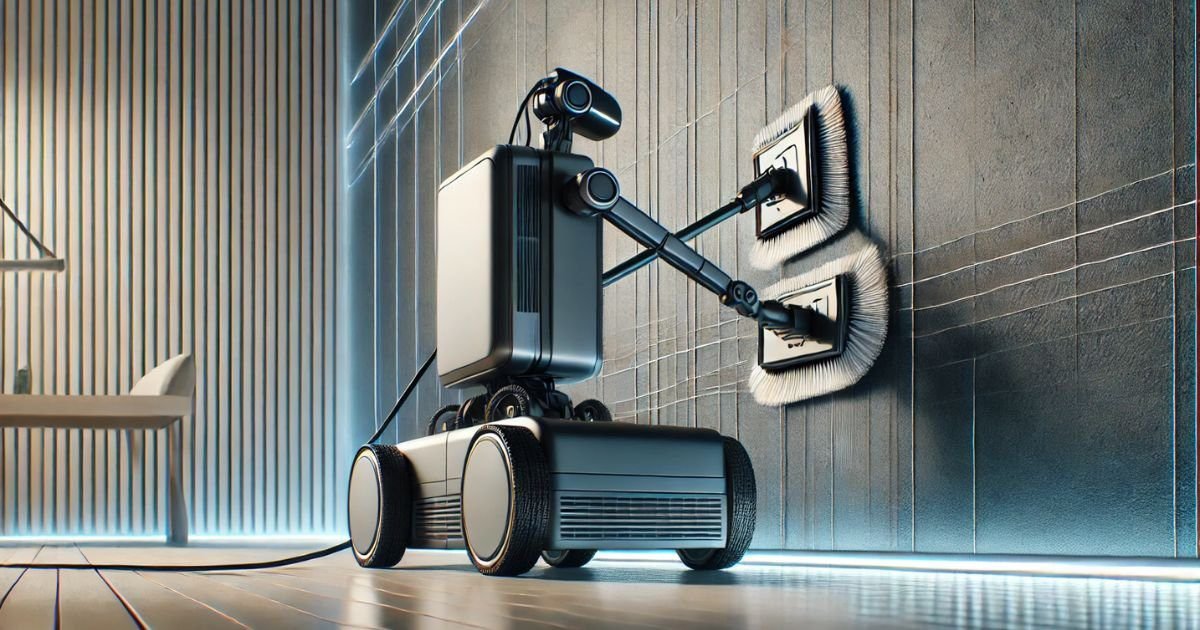Wall Cleaning Robot is a cutting-edge solution for effortlessly maintaining cleanliness on vertical surfaces. In today’s fast-paced world, cleaning high walls, ceilings, and windows has always been a daunting and time-consuming task. A wall cleaning robot eliminates the need for ladders or professional cleaners, providing an efficient and safe alternative. These robots are designed to automatically adhere to walls using advanced suction technology, making them suitable for both residential and commercial spaces. With AI-powered navigation and smart sensors, these robots ensure that every inch of the wall is cleaned without leaving any streaks or dirt behind.
How a Wall Cleaning Robot Works
A wall cleaning robot is engineered to provide efficient and automated cleaning of vertical surfaces. Here’s a breakdown of how these robots operate:
Suction Technology: Most wall cleaning robots use strong suction to cling to walls, allowing them to move vertically without the risk of falling. This suction power helps the robot stay securely attached, even on smooth or textured surfaces.
Navigation and Sensors: Equipped with advanced sensors, these robots can detect obstacles, edges, and corners, ensuring they navigate the surface methodically. The sensors help the robot avoid falling off the wall, ensuring it cleans all areas without missing spots.
Cleaning Mechanisms: A wall cleaning robot can be fitted with various cleaning tools like microfiber cloths, brushes, or even mops, depending on the surface. These tools work effectively to remove dirt, stains, and dust from walls without damaging the surface.
Smart Control: Many models can be controlled remotely via smartphone apps, making it easy for users to start, stop, or adjust settings.
Types of Wall Cleaning Robots
There are various types of wall cleaning robots, each tailored to meet specific cleaning requirements and environments. Here are the most common types:
Domestic Wall Cleaning Robots: These robots are designed for home use, typically focusing on smaller surfaces like painted walls, tiles, and windows. They are lightweight, easy to operate, and often come with features like remote control and app connectivity. These models are ideal for homes with limited wall space or for people who need a convenient cleaning solution for everyday use.
Industrial Wall Cleaning Robots: Built for commercial and industrial applications, these robots are more robust and powerful. They are designed to clean large surfaces in high-rise buildings, warehouses, and factories. Industrial models often have stronger suction power, longer battery life, and advanced safety features to ensure efficient cleaning in challenging environments.
Specialized Wall Cleaning Robots: These robots are tailored for specific tasks, such as graffiti removal, glass facade cleaning, or high-altitude window cleaning. They come with specialized brushes and cleaning solutions suited for their unique purposes.
Important Features to Consider When Choosing a Wall Cleaning Robot
When selecting a wall cleaning robot, it’s important to consider key features that ensure optimal performance and efficiency.
Suction Power and Cleaning Efficiency
Powerful suction is crucial for a wall cleaning robot to remain firmly attached to walls. It also enhances the robot’s ability to remove dirt, dust, and stains effectively, ensuring a thorough clean.
Navigation and Sensors
Look for robots with advanced navigation systems and safety sensors. These help the robot avoid obstacles, detect edges, and prevent it from falling off walls.
Battery Life and Charging
A long-lasting battery ensures the robot can clean for extended periods. Additionally, fast charging capabilities can reduce downtime between cleanings.
Smart Control Features
Choose robots with smart features like remote control or app connectivity. These allow easy customization and scheduling for convenient, hands-free cleaning.
Must Read: Faqlogin.com Home Improvement: Increasing Home Value
Benefits of Using a Wall Cleaning Robot
Utilizing a wall cleaning robot provides numerous benefits that simplify and enhance the cleaning process.
Time and Effort Savings: A wall cleaning robot significantly reduces the time and physical effort required for cleaning walls, especially in hard-to-reach areas like ceilings or high windows. Consistent Cleaning: Unlike manual cleaning, a robot can provide consistent results every time, ensuring thorough coverage without missing spots. Enhanced Safety: A wall cleaning robot removes the necessity for ladders or scaffolding, minimizing accident risks and making it safer to clean elevated or hard-to-reach areas. Economical: In the long run, these robots help save money by decreasing the reliance on professional cleaning services and reducing the costs of cleaning supplies and labor.
Choosing the Right Wall Cleaning Robot for Your Needs
When selecting a wall cleaning robot, it’s important to match its features to your specific needs. For residential use, consider the size of your walls and the types of surfaces you need to clean. If you have painted walls or tiles, a lightweight, compact model with gentle cleaning brushes or microfiber cloths will suffice. On the other hand, if you’re looking for a wall cleaning robot for commercial or industrial use, opt for models with stronger suction, longer battery life, and enhanced durability to handle larger, tougher surfaces.
Additionally, assess the robot’s navigation capabilities and safety features, especially if you need it to work on high or difficult-to-reach areas. Don’t forget to factor in budget, as residential models tend to be more affordable than industrial ones. Make sure to choose a robot that aligns with your cleaning goals and environment.
Wall Cleaning Robot: Common Issues and Troubleshooting
While wall cleaning robots offer convenience, they may occasionally experience issues. One common problem is the robot falling off the wall due to insufficient suction power or a weak battery. To fix this, check the suction system and ensure the battery is fully charged. Another issue could be sensors malfunctioning, preventing the robot from detecting edges or obstacles. In such cases, cleaning the sensors and recalibrating them can often resolve the problem. If the robot isn’t cleaning efficiently, inspect the brushes or cloths for dirt buildup or wear and tear.
Regular maintenance, such as cleaning filters, checking the battery, and updating software, can prevent many issues. For more severe malfunctions, consult the manufacturer’s support for troubleshooting or repair guidance.
Future of Wall Cleaning Robots: Trends and Innovations
The future of wall cleaning robots is poised for significant advancements, driven by technological innovations and evolving industry needs.
AI-Powered Navigation and Smart Mapping
Future wall cleaning robots will incorporate advanced artificial intelligence to enhance navigation and mapping capabilities These robots will employ AI to assess wall surfaces, identify dirt patterns, and streamline cleaning routes, ensuring a comprehensive and effective clean. This intelligent mapping will enable robots to adapt to various wall types and conditions, providing customized cleaning solutions.
Integration with Smart Building Systems
As smart buildings become more prevalent, wall cleaning robots will integrate seamlessly with building automation systems. This integration will allow for scheduled cleaning tasks, real-time monitoring, and remote control via smartphones or central management systems. Such connectivity will enhance operational efficiency and ensure consistent maintenance of building facades.
Sustainable and Eco-Friendly Cleaning Solutions
Environmental sustainability will be a key focus in the development of future wall cleaning robots. Manufacturers are exploring the use of eco-friendly cleaning agents, water-saving technologies, and energy-efficient designs. These innovations aim to reduce the ecological footprint of cleaning operations while maintaining high performance.
Enhanced Safety Features
Safety will remain a priority, with future robots equipped with advanced sensors to detect structural anomalies and prevent accidents. Additionally, features like automatic shutdown in case of malfunction and real-time alerts will be standard, ensuring the safety of both the robot and the building occupants.
Autonomous High-Rise Cleaning
The demand for cleaning high-rise buildings will drive the development of autonomous wall cleaning robots capable of safely and efficiently cleaning tall structures. These robots will employ advanced climbing mechanisms and stability controls to navigate vertical surfaces, reducing the need for scaffolding and enhancing worker safety.
Conclusion
In conclusion, wall cleaning robots are revolutionizing the way we approach maintaining vertical surfaces, offering significant time savings, increased safety, and consistent results. With advancements in AI, smart navigation, and eco-friendly designs, these robots are becoming increasingly efficient and accessible for both residential and commercial use. As technology continues to evolve, the future of wall cleaning robots looks promising, with innovations that will make cleaning even more automated, sustainable, and intelligent.
By choosing the right model, users can ensure their spaces remain spotless while reducing manual effort and cost. The rise of these robots marks a new era of smart, efficient cleaning solutions.
Thanks for visiting Globalexpressinfo.com. Don’t forget to share it on Twitter.






